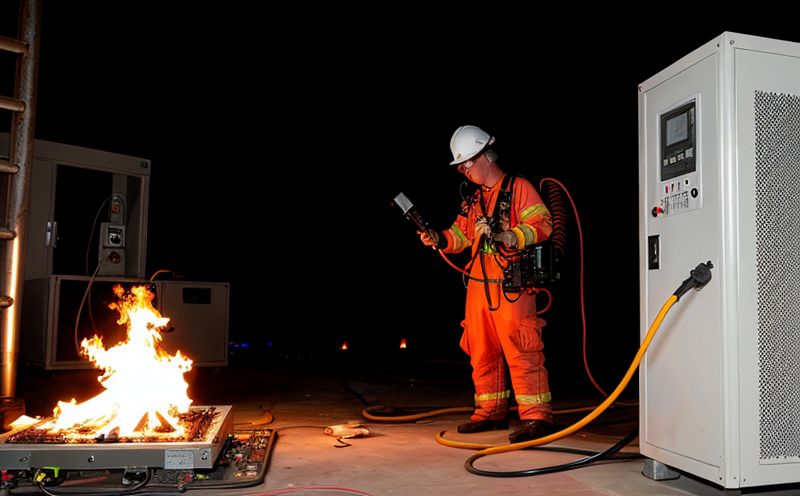Reaction-to-Fire Testing for Power Cords
The reaction-to-fire testing of power cords is a critical aspect of ensuring electrical and electronic equipment (EEE) complies with international safety standards. This testing evaluates how the materials in power cord assemblies react when exposed to fire, which is crucial given that faulty or inadequately tested power cords can lead to fires, causing significant property damage and potential loss of life.
The test method typically involves subjecting a specimen to controlled flame exposure under specified conditions. The primary objective is to assess the time it takes for the ignition source to be extinguished by the materials in the cord assembly, as well as any post-test evaluation of the char depth, weight loss, and other parameters that indicate material behavior during combustion.
The testing apparatus used includes a specialized furnace with regulated air flow, temperature control, and an integrated camera system for capturing video footage throughout the test. The specimens are prepared in accordance with relevant standards such as IEC 60335-1, which specifies the general requirements and tests for household appliances.
The results of reaction-to-fire testing provide critical information to engineers during the design phase of new products or modifications to existing ones. They can identify potential fire hazards early on, allowing for necessary improvements to be made before a product reaches market. Additionally, these test results are often required by regulatory bodies as part of the certification process.
Compliance with standards like IEC 60335-1 is not only a legal requirement but also a best practice in the industry. It ensures that products meet rigorous safety criteria and can be trusted to perform reliably under various conditions, including those that might inadvertently expose them to fire hazards.
Why It Matters
The importance of reaction-to-fire testing for power cords cannot be overstated, particularly in sectors where electrical equipment is used frequently and in close proximity to flammable materials. In industrial settings, for instance, a single malfunctioning power cord could ignite an entire facility, causing extensive damage and endangering workers' lives.
From a consumer perspective, products that pass rigorous fire safety tests provide peace of mind and enhance trust in the brand. This is especially true given recent high-profile incidents involving faulty electrical equipment contributing to fires. The public's growing awareness of these risks has led to increased demand for safer products, driving manufacturers to adopt stringent testing protocols.
Additionally, fire safety testing plays a key role in reducing insurance premiums and mitigating liability risks for companies involved in the design, manufacturing, and distribution of EEE. By demonstrating compliance with international standards, businesses can bolster their reputation as responsible corporate citizens.
Environmental and Sustainability Contributions
- Emissions Reduction: By identifying and rectifying fire hazards early in the product lifecycle, reaction-to-fire testing helps reduce the risk of accidental fires. This minimizes the release of harmful smoke and toxic gases into the environment.
- Resource Efficiency: Products that pass these tests are less likely to be recalled or scrapped due to safety concerns. This promotes more efficient use of raw materials throughout the supply chain.
The testing process itself also contributes positively by encouraging manufacturers to select non-toxic and recyclable materials, which further supports environmental sustainability goals. Regulatory bodies often include these factors when assessing a company's overall commitment to responsible manufacturing practices.
Use Cases and Application Examples
| Application Example | Description |
|---|---|
| Electrical Appliances in Industrial Settings | Testing power cords used for industrial machinery ensures they can withstand the rigors of continuous operation while minimizing fire risks. |
| Homes and Apartments | Evaluating the safety of power cords within residential spaces helps prevent accidental fires that could originate from faulty or inadequately tested cords. |
| Public Buildings | The use of reaction-to-fire testing in public facilities guarantees a safer environment for occupants, reducing potential hazards during emergencies. |
- Electrical devices used in hazardous locations require stringent fire safety measures to prevent explosions and fires from igniting.
- Innovative electronic products that incorporate advanced materials need thorough testing to ensure they meet the highest fire safety standards.





